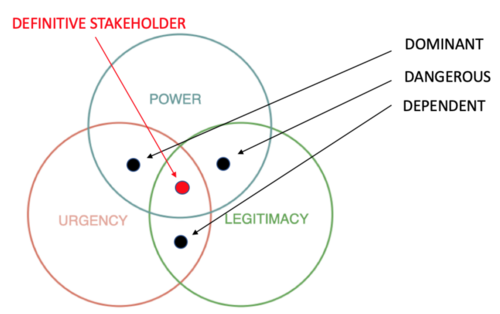Example APPPM 2020
Collection of tools
Salience Model by PMI [1]
Salience Model is a tool used to classify relevant stakeholders, with the aim of monitoring stakeholder management. This classification is based on assessments of their power, urgency, and legitimacy. The Salience Model is useful for projects, programs or portfolios with a large complex number of stakeholders or if complex networks of relationships have to be monitored. It is also useful in determining the relative importance of the identified stakeholders.

Service Blueprinting [3]
A service blueprint is a diagram that displays the entire process of service delivery, by listing all the activities that happen at each stage, performed by the different roles involved. The service blueprint is built by first listing all the actors involved in the service process on a vertical axis, and all the steps required to deliver the service on the horizontal axis. The resulting matrix allows to represent the flow of actions that each role needs to perform along the process, highlighting the actions that the user can see (above the line of visibility) and the ones that happen in the back-office (below the line of visibility). Roles can be performed by human beings or other types of entities (organizations, departments, artificial intelligences, machines, etc.).
Personas [4]
Each persona is a reference model representative of a specific type of users. Technically, they can be called behavioral archetypes when they focus on capturing the different behaviors (e.g. “the conscious chooser”) without expressing a defined personality or socio-demographics. The more the archetypes assume a realistic feeling (e.g. name, age, household composition, etc.), the more they become real personas, fully expressing the needs, desires, habits and cultural backgrounds of specific groups of users.
SMART goals technique [5]
The SMART goals technique, first described by George T. Doran [6], was developed to support applicants by achieving tasks through following the SMART guideline. The acronym SMART stands for: Specific, Measurable, Achievable, Relevant (sometimes: relatable), Time bound. The formulation of goals in a specific way demands that it is precise and clear what is supposed to be achieved by it. Making a goal measurable ensures a better controlling of them. By making a goal “achievable”, a project manager should make sure, that the process is elaborate regarding time, cost and human resources. Also, each goal should not exceed a certain amount of work but be divided into smaller work packages. The “relevant” aspect asks the applicant to evaluate the goal regarding its relevance to the project. Finally, the goal should also have a deadline assigned to it.[7] The formulation of any goal according to this standard allows the applicant to reach them in a more efficient way. Its simple application has made the SMART technique popular with both, private and professional goal setting. Additionally, one of the many advantages the technique offers is its great compatibility with other tools, such as the Eisenhower Matrix.[8]
Work Breakdown structure and Product breakdown structure [9]
According to the Project Management Insitiute’s Book of Knowledge (PMBOK), the work-breakdown structure (WBS) “is the process of subdividing project deliverables and project work into smaller, more manageable components.”[10]. This helps the project manager to not only make the project more manageable by having more control over smaller steps and a guidance for schedule development but also more predictable regarding time and cost estimations. [11]
WBS is breaking down a project hierarchically and incrementally into phases, deliverables and work packages, forming a tree structure. The development process of the WBS starts at the goal or end objective and is structured into several milestones, ultimately reaching back to the project’s start. Each milestone can then be further subdivided into manageable tasks rearding its size and duration. One great advantage is that these smaller tasks can be formulated with the above-mentioned SMART-goals technique to make them easier to achieve. [12] Like the WBS is the product breakdown structure (PBS) which does an analogous breakdown of the product. Even though its process and structure are fairly similar to the WBS, it is an isolated entity and is applied at a different stage in the planning process.[13]
References
- ↑ Project Management Institute, Inc.. (2017). Guide to the Project Management Body of Knowledge (PMBOK® Guide) (6th Edition). (pp. 513). Project Management Institute, Inc. (PMI). Retrieved from https://app-knovel-com.proxy.findit.dtu.dk/web/view/khtml/show.v/rcid:kpGPMBKP02/cid:kt011DXO32/viewerType:khtml//root_slug:13-project-stakeholder-management/url_slug:project-stakeholder-management?kpromoter=federation&b-toc-cid=kpGPMBKP02&b-toc-root-slug=&b-toc-url-slug=project-stakeholder-management&b-toc-title=Guide%20to%20the%20Project%20Management%20Body%20of%20Knowledge%20(PMBOK%C2%AE%20Guide)%20(6th%20Edition)&page=11&view=collapsed&zoom=1
- ↑ Ronald K. Mitchell, Bradley R. Agle, Donna J. Wood. The Academy of Management Review, Vol. 22, No. 4, 1997, p872
- ↑ (2007) Mary Jo Bitner, Amy L. Ostrom, Felicia N. Morgan, Service Blueprinting: A Practical Tool for Service Innovation, Centre for Services Leadership, Arizona State University, paper
- ↑ (2009) Kim Goodwin, Designing for the Digital Age: How to Create Human-centered Products and Services, John Wiley & Sons.
- ↑ Doran, G. T. (1981). "There's a S.M.A.R.T. way to write management's goals and objectives". Management Review. 70(11): 35–36., Retrieved February 22, 2020
- ↑ Doran, G. T. (1981). "There's a S.M.A.R.T. way to write management's goals and objectives". Management Review. 70(11): 35–36., Retrieved February 22, 2020
- ↑ Doran, G. T. (1981). "There's a S.M.A.R.T. way to write management's goals and objectives". Management Review. 70(11): 35–36., Retrieved February 22, 2020
- ↑ https://www.habitify.me/blog/why-goal-setting-is-important-for-leaders
- ↑ 2008 Project Management Institute. A Guide to the Project Management Body of Knowledge (PMBOK® Guide) — Fourth Edition
- ↑ 2008 Project Management Institute. A Guide to the Project Management Body of Knowledge (PMBOK® Guide), p. 49 — Fourth Edition
- ↑ Booz, Allen & Hamilton Earned Value Management Tutorial Module 2: Work Breakdown Structure, Office of Science, Tools & Resources for Project Management, science.energy.gov. Retrieved February 22, 2020
- ↑ NASA (2001). NASA NPR 9501.2D, https://nodis3.gsfc.nasa.gov/displayCA.cfm?Internal_ID=N_PR_9501_002D_&page_name=Chp2, Retrieved Feburary 22, 2020.
- ↑ Duncan Haughey. (2015) ‘Project Management Tools’, Project Smart. Available from: https://www.projectsmart.co.uk/project-management-tools.php